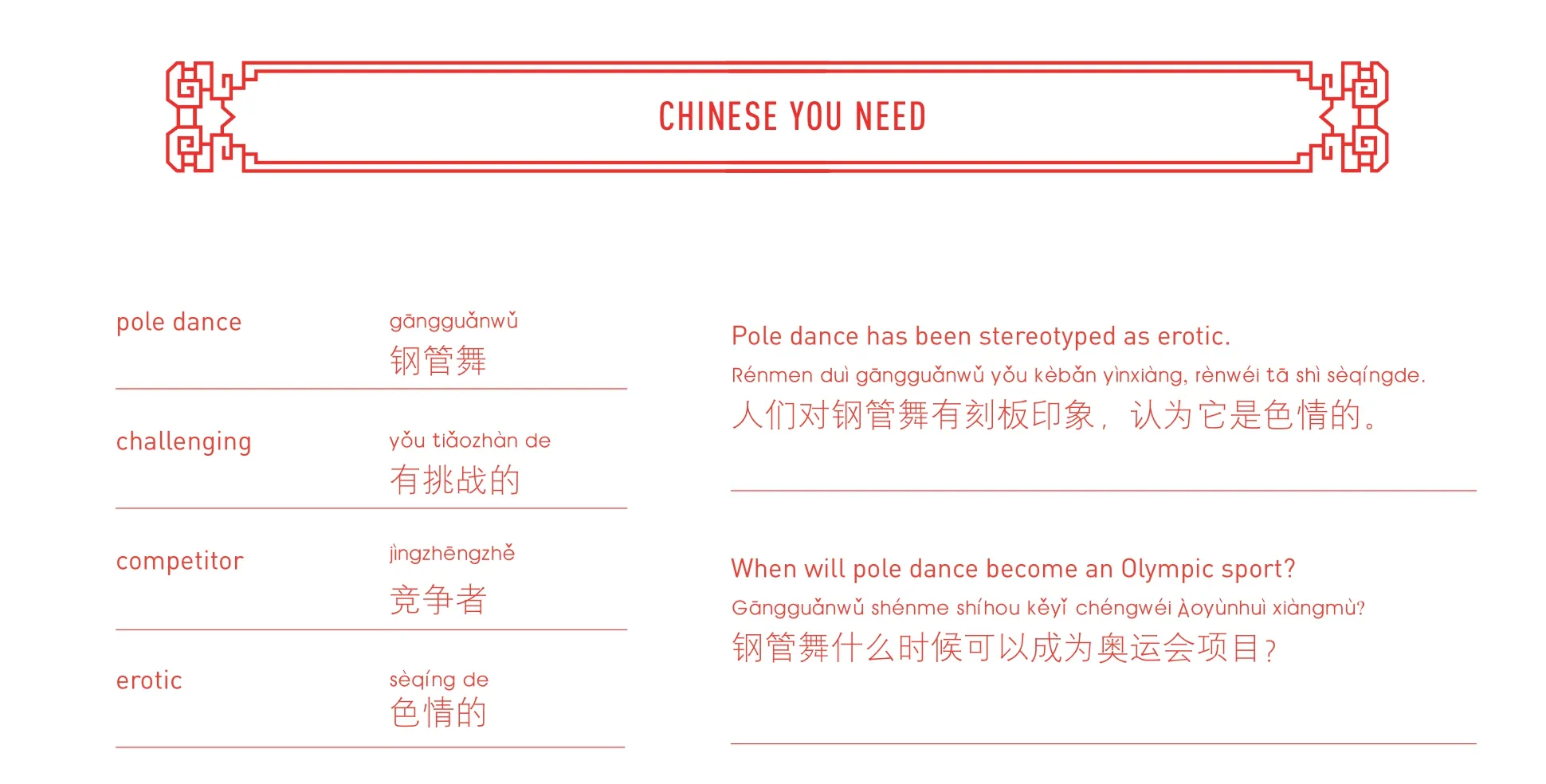THE WAY OF THE POLE
2013-08-02BYTYLERRONEYAND
BY TYLER RONEY AND
KEONI EVERINGTON (华武杰)
THE WAY OF THE POLE
BY TYLER RONEY AND
KEONI EVERINGTON (华武杰)
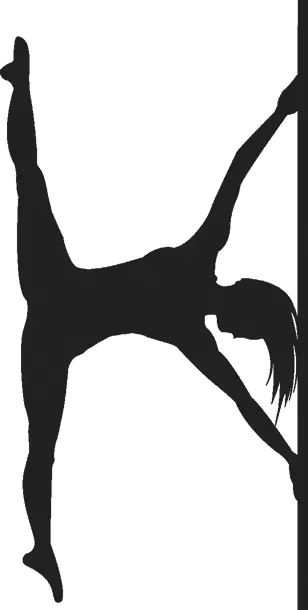
钢管舞属于灯红酒绿?那你就OUT了!它是优美的表演艺术,也许还是下届“奥林匹克”的新项目。
China’s pole dance pioneers vie for a spot on the international stage
Cao Nuo (曹诺) stretches on the hardwood floor, arching, cracking and straining her dragontattooed back inside her tight, red tank top, a perfect triangle becoming clear on her inflated deltoid muscles. Her left shoulder sports a heart-shaped “Mom” tattoo and her abdomen, built of three perfectly shaped rows of chiseled abs, swoop down into her light blue, form-fitting spandex shorts, quickly giving way to rock solid thighs. The head coach gives the command, and she violently slaps chalk on her hands before leaping at the pole. One-handed, she propels herself vertically, executing three complex moves in a matter of seconds with maximum momentum but an elegant flow. In the quiet setting, the sound of metal on flesh screeches through the air as Cao switches limbs, propelling gracefully around the pole. Her body curls like a cat licking its back. She spins faster and faster. As her momentum slows, she puts on the brakes, turns upside down, spreads her legs wide and holds the pose. It’s called the “Batman”. She ends with inverted splits (“Flag Back Roll”) and hops off the pole with a playful, girlish giggle, flicking back her hair. The impressed look on her teammates’ faces and her coach’s solemn glare betray the gravity of the training. Her grace, musculature and flawless technique aren’t meant for getting grown men sweaty in some smoky club. She lives for the love of the game.

Cao Nuo poses on a pole over the Tianjin skyling on the roof of the CPDSTC studio, where China's pole dancers go to become pros
The China Pole Dance Sports & Training Center (CPDSTC) located in the heart of Tianjin is where China trains its premier pole dancers. The sport is getting a lot of attention and not just because of the opportunity for lechery. When standing in a room full of beautiful, scantily clad women, it should be made clear that it is actually a room full of beautiful, scantily-clad champions.
Cao placed third at the China Pole Dance Championship in 2011, topped by CPDSTC’s other rising star, Song Yao (宋瑶). Male dancer Yan Shaoxuan (闫少轩) took home the eighth spot at the World Pole Dance Sport & Fitness Championship, and China fielded its first pole-dancing team ever at the 2012 World Pole Dance Sport & Fitness Championships in Zurich. So far, China’s international performance in the sport has been underwhelming, but hopes are high for 2013.
Though pole dancing has a reputation as more of a striptease than a sport, it is taken very seriously by a select few. Everything from the height of the pole to the duration of the song is taken into account, and points are deducted mercilessly; a minor slip or a bent leg could cost you an entire point out of 30.
In the past decade, pole dancing has evolved into doubles, singles, men, and women competing for cash and glory. Coaches and athletes are keen to get their athletes into major international competitions such as The British World Pole Dancing Championship, Pole Art from (you guessed it) Poland, and the International Pole Dancing Championship. While Chinese pole dancers want representation at all three, the World Pole Dance Sport Fitness & Championship is the most prestigious and has competitors from over 30 countries. To much state media fanfare, China fielded its first team last year, and despite not getting top marks, still made an impressive first showing
Of course, every army needs its general. Enter, Meng Yifan (孟依繁), the team captain. She is statuesque with the regal air of a prima ballerina. From a young age, she was schooled extensively in folk, ballet, modern, and jazz dance.
Yifan, a native of Tianjin, first saw a video of Chinese pole dancers online in 2005. That was before CPDSTC had gotten their feet on the ground, so she did what any young woman in her position would do: she taught herself. However, while many would just hit the internet looking for a gym with a pole, Yifan took a different approach.
“I bought a pole and installed it in my house to practice on,” she says, laughing at the memory. Back then, there wasn’t really an official channel for Chinese pole dancers to apply, so she made a video herself and, once she felt her skills were up to snuff, submitted it to the World Pole Dance Sport & Fitness Championship, becoming the first Chinese citizen to be accepted to the prestigious international tournament. She placed 24th and forged a path for international pole dancing in China.
“Being taller makes it much more difficult to execute the more acrobatic moves, but if you can pull it off, it looks better,” Yifan says, confident in her answer, confidence that has been duly earned. In many ways, she is a pioneer, and with that responsibility, she’s an expert pole dance technician, more than happy to demonstrate.
Without another word, she dives into the “Hand Spring Deadlift”. It’s a simple move, but to make the point (and probably to show off a bit), she holds the pose for half a minute. She then cocks her right leg into a “Shoulder Mount”, dropping her other leg to form an “Iron X”holding the pose as her face turns red from the strain. Far from finished, she shimmies up the pole and inverts her body for a “Chopper” and shoots upright for a“Superman” pose, which features her long toned legs wrapped tightly around the pole with one arm extended like a superhero in flight. She ends the exhibition with a“Flatline Scorpio” move.
Like many of her teammates, Yifan believes in pole dancing and has faith that, someday, people will recognize it for the sport and art it truly is.
Few people have as much faith in pole dancing as promoter and head coach Yuan Biao (袁标). He has made concerted efforts to ramp up China’s competitive edge in the realm of international pole dancing. In fact, competitive pole dancing on the international stage may still lack that China luster if it hadn’t been for this curiously gung-ho leader, who is quick to mention that they receive no government funding.
THE MOVES THEMSELVES CAN BE DRAMATIC OR EVEN DEATH DEFYING
He sold his house and car in the beginning to try to keep this sport alive on the mainland. In short, Yuan is China’s pole dance pit-bull, using every chance he can to advance the sport and his athlete’s profiles. He says pole dancing has the potential to become China’s most popular sport, believing China is where pole dancing began.
“Legend has it that pole dancing has its roots in Chinese acrobatics, but it branched out into the many art forms we see today,” he says. The famous “Chinese Pole” acrobatics have stunned many a curious tourist, but pole dance as a sport is entirely different.
The history of pole dance can be traced to a number of places, from a gymnastic art on a wooden pole in India to Great Depression era men trying to make ends meet by performing feats of daring on tent poles in the US. Pole dancing as we know it today did not really gain its association as a fleshy, female exotic dance until the 1990s, and the past decade has seen it become a popular (even mainstream) form of fitness and sport.
Regardless of where it began, this sport is popular in many countries around the world. As such, standardized rules have been put in place to make sure that competitors vie on even footing. Yuan excitedly points out that the entrants are judged on an array of areas, including difficulty, strength, aesthetic, performance, and the moves themselves. As with any international competition, uniform rules are the key to legitimacy.
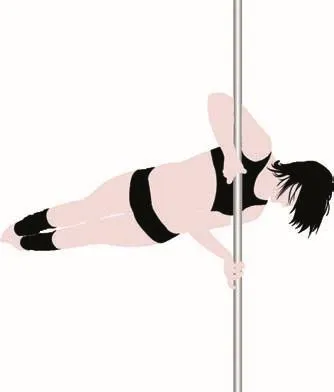
HALF FLAG
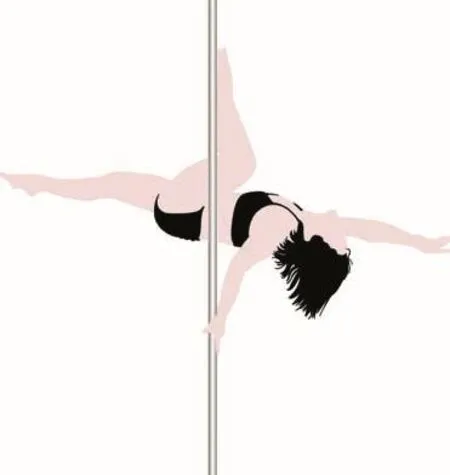
FLATLINE SCORPIO
It’s also important to note that pole dancing competitively takes commitment. Those at CPDSTC trainhard, and their bodies are a testament to that dedication; being in peak physical condition is obligatory. Before a major competition, dancers train for over four months sometimes, longer than many boxers for a big bout.
A quick trip down to Tianjin for the day will show any interested observer exactly how severe the training can be. The moves themselves can be dramatic or even death defying, so elasticity is key. The first and longest phase of the training is to improve flexibility, or 柔韧度 (róurèndù). The stretching is just like you would see in any gym, but more aggressive. Next come bouncing lunges, the side splits, and front splits, then on to pushups and extensive core strengthening exercises such as inverted sit-ups, using only their thighs to maintain their grip on the pole.
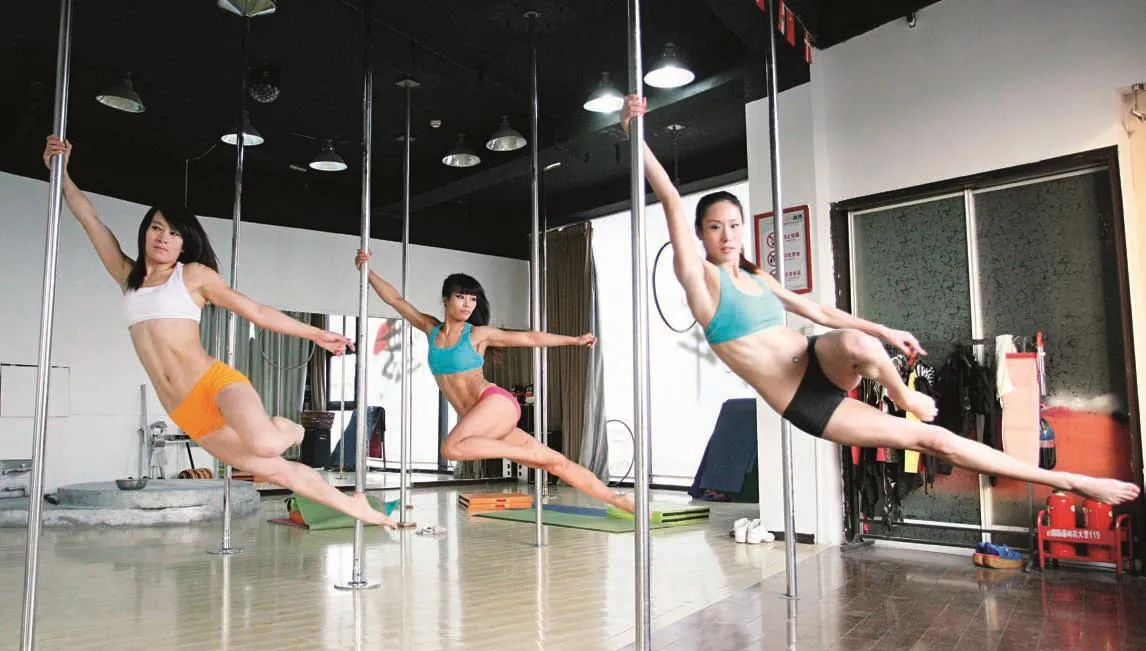
DancersMeng Yifan, Cao Nuo, and Song Yao swing in unison as they prepare for the China Pole Dance Championship
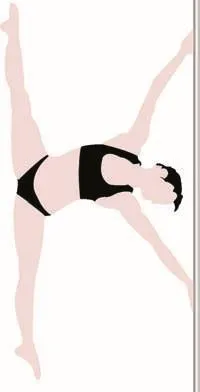
IRON X

CHOPPER

RAINBOW MARCHENKO
That’s how they start. From then on, it’s a series of stamina, endurance and strength exercises that prepare them for six solid minutes with their feet off the ground. There is, however, another side to pole dancing, one thatputs the gloss on all this hard work. On May 17 and 18, pole dancing hit the theaters in Tianjin. Team captain, Yifan, the face of the group made the decision to take the dancers to the theater. She told the Global Times earlier this year that there are three different stages to lifting pole dancing’s profile: “the dance”, “the tournament”, and “the art”.
With their latest foray at the Tianjin Grand Theater, art is the last pin to fall. In the 90-minute dance drama entitled “Fairies on the Pole”, 26 glamorous dancers from CPDSTC and across the country stage a dazzling three-act performance aimed to charm and educate the general public about this new art form. The performance began with each dancer executing their signature pose. The athletic aspect of pole dancing soon gave way to its soft side in the second act, with a doubles dance routine inspired by “Butterfly Lovers”(《梁祝》 Liángzhù) in which dancers move gracefully and imitate two butterflies fluttering in the air, swirling up and down, entwining and stretching on the poles.
“The dance drama was a huge success!” Yuan declared.
“It’s so intense that I don’t think any of our viewers got any restroom time,” he joked. “Many of them just couldn’t get enough of it, and they got tickets to see it again the very next day.” Lead dancer Yifan was cheered by enthusiastic fans, some of whom had put together scrapbooks to sign and made calligraphy to compliment her work. While dancers and organizers left the theater feeling proud of their sweat and effort for the past two years.
The performance ended with a realistic depiction of the widespread misunderstanding the dancers struggle against.
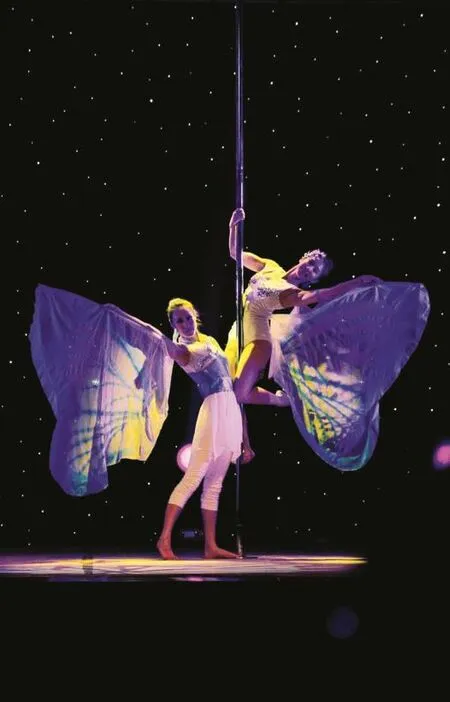
Two talented pole dancers take part in Butterfly Lovers, part of an exhibition in Tianjin to raise pole dancing's profile as a sport and an art
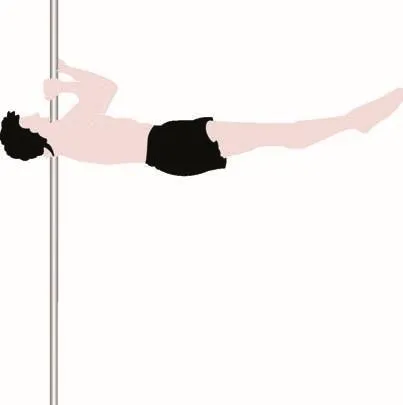
AIR SHOULDERMOUT
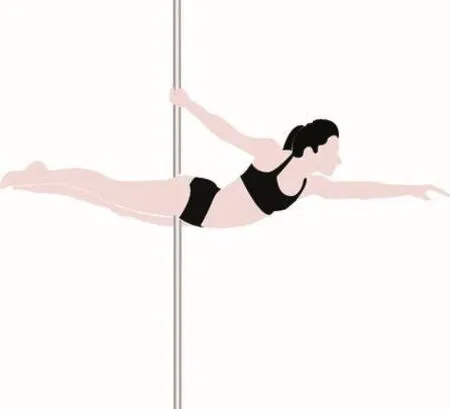
BULLET SPIN TO SUPERMAN

TWISTED GRIP HANDSPRING DEAD LIFT
Online reactions varied, but some didn’t like the idea of pole dancing as an art. “The obscene performancein Western strip clubs has gone so far as to raise itself to an art form in China. What kind of ‘cultural confidence’is this? Such spectacle has completely made a fool of the Chinese people in front of the world!” claimed one offended Weibo blogger. Also, a heated discussion started on Tencent News under the news entry of the debut where opinion is split between “low-class and erotic”, and“innovative and artful”.
Despite the divisive reviews, Yuan still felt confident about promoting pole dancing as a performing art. “Because of the dance element, I think pole dance is quite suitable for stage performances, besides being a competitive sport.”
But, there is also the big picture to consider: “We need a business model for pole dancing to flourish and dance drama might be our answer.” The next step, according to Yuan, is to expand and enrich the performance and tour the country.
That said, the main future for pole dance lies in competitive sports, and the endgame for all pole dancers is to get the ultimate recognition: a spot in the Olympic Games. As of now, pole dancing in China gets little to no government support, but a place in the Olympics would change all of that, an opportunity to grab some money from the public coffers. When asked if she thought there was hope for pole dancing at the largest sporting event in the world, hopeful newcomer Cao says, “Yes, but probably not this year. However, we are working very hard on it.”
These dedicated Chinese dancers aren’t the only ones hoping to get pole dancing into the Games. The International Pole Sports Federation has been lobbying the committee for years to get some recognition and hopes are high for 2016. In 2010, the International Pole Sports Federation managed to round up 6,000 signatures to make the 2012 Games (under the title“vertical dance”). Sadly, they fell short of what it took to impress the committee then. For that, the Olympic Committee has taken a few hits, with many fans poking fun at the some of the Games’ more eccentric sports, like “racewalking”.
Team captain, Yifan, has devoted her entire life to the sport and is pretty optimistic. “It will take time for them to change the categories right now. There aren’t yet enough studios around the world now. It would be a big change for China. The aspects are different from gymnastics and much less boring.”
Yuan even thinks that pole dancing has more of a right to be there than some other sports, citing creativity. He believes the sport is superior to gymnastics because it has a wider variety of possible moves and that the athletes have only begun to explore the vast permutations of skills that can be displayed on the pole
There are, of course, those who disagree. Pole dancing has a lot working against it: it is a newcomer to the dance world, scoring lacks complete standardization, each region has different moves, and some believe pole dancing should stay in the realm of art. But, for now, professional pole dancers are content to lose their “stripper” image and make a bigger splash in the world of sport.
